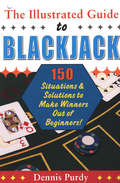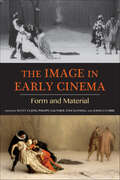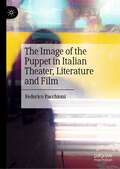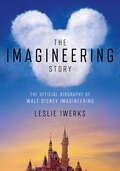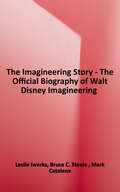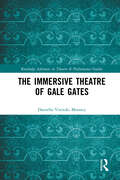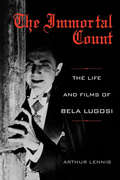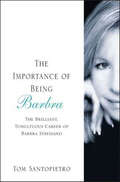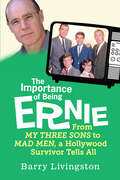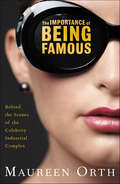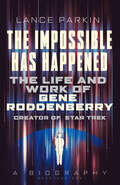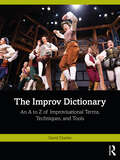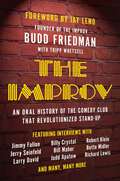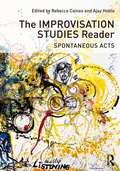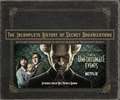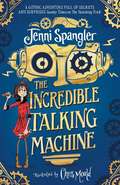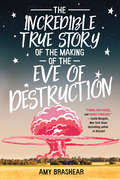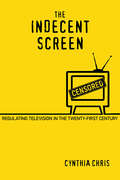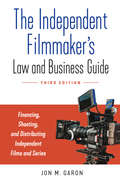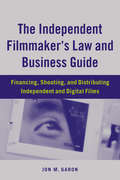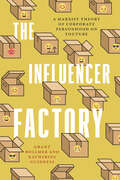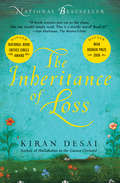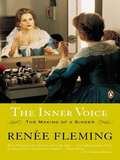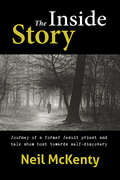- Table View
- List View
The Illustrated Guide to Blackjack
by Dennis PurdyYou’ve got a pair of jacks. The dealer shows a seven. Do you split or stand? The Illustrated Guide to Blackjack will show you the right move to make in this and every possible blackjack scenario, using real-game situations and solutions that test and hone your skills to the max. Former gambling pro Dennis Purdy not only reveals the best plays for each hand, he shows you why they work, with clear, concise logic, user-friendly charts, and a unique flashcard format that makes each lesson stick. Mastering essential strategy has never been faster or easier. Whether you’re visiting the tables for the first or the fiftieth time, The Illustrated Guide to Blackjack will teach you how to keep on winning, again and again.
The Image in Early Cinema: Form and Material (Early Cinema In Review: Proceedings Of Domitor Ser.)
by Scott Curtis Joshua Yumibe Tom Gunning Philippe GauthierIn The Image in Early Cinema, the contributors examine intersections between early cinematic form, technology, theory, practice, and broader modes of visual culture. They argue that early cinema emerged within a visual culture composed of a variety of traditions in art, science, education, and image making. Even as methods of motion picture production and distribution materialized, they drew from and challenged practices and conventions in other mediums. This rich visual culture produced a complicated, overlapping network of image-making traditions, innovations, and borrowing among painting, tableaux vivants, photography, and other pictorial and projection practices. Using a variety of concepts and theories, the contributors explore these crisscrossing traditions and work against an essentialist notion of media to conceptualize the dynamic interrelationship between images and their context.
The Image of the Puppet in Italian Theater, Literature and Film
by Federico PacchioniWith the advancement of cybernetics, avatars, animation, and virtual reality, a thorough understanding of how the puppet metaphor originates from specific theatrical practices and media is especially relevant today. This book identifies and interprets the aesthetic and cultural significance of the different traditions of the Italian puppet theater in the broader Italian culture and beyond. Grounded in the often-overlooked history of the evolution of several Italian puppetry traditions – the central and northern Italian stringed marionettes, the Sicilian pupi, the glove puppets of the Po Valley, and the Neapolitan Pulcinella – this study examines a broad spectrum of visual, cinematic, literary, and digital texts representative of the functions and themes of the puppet. A systematic analysis of the meanings ascribed to the idea and image of the puppet provides a unique vantage point to observe the perseverance and transformation of its deeper associations, linking premodern, modern, and contemporary contexts.
The Imagineering Story (Disney Editions Deluxe)
by Leslie IwerksThe highly acclaimed and rated Disney+ documentary series, The Imagineering Story, becomes a book that greatly expands the award-winning filmmaker Leslie Iwerks' narrative of the fascinating history of Walt Disney Imagineering.The entire legacy of WDI is covered from day one through future projects with never-before-seen access and insights from people both on the inside and on the outside. So many stories and details were left on the cutting room floor―this book allows an expanded exploration of the magic of Imagineering. So many insider stories are featured. ° Sculptor Blaine Gibson’s wife used to kick him under the table at restaurants for staring at interesting-looking people seated nearby, and he’d even find himself studying faces during Sunday morning worship. “You mean some of these characters might have features that are based on people you went to church with?” Marty Sklar once asked Gibson of the Imagineer's sculpts for Pirates of the Caribbean. “He finally admitted to me that that was true.”° In the early days, Walt Disney Imagineering "was in one little building and everybody parked in the back and you came in through the model shop, and you could see everything that was going on,” recalled Marty Sklar. “When we started on the World’s Fair in 1960 and 1961, we had 100 people here. And so everybody knew everything about what was happening and the status of [each] project, so you really felt like you were part of the whole team whether you were working on that project or not. And, you know, there was so much talent here.” A must-have for Disney Parks fans!Searching for that perfect gift for the #1 Disney fan in your life? Explore more behind-the-scenes stories from Disney Editions:One Little Spark! Mickey's Ten Commandments and The Road to Imagineering (By Disney Legend Marty Sklar)Magic Journey: My Fantastical Walt Disney Imagineering Career (By Kevin Rafferty)Travels with Walt Disney: A Photographic Voyage Around the World (By Jeff Kurtti)Eat Like Walt: The Wonderful World of Disney Food (By Marcy Carriker Smothers)Walt Disney: An American Original (By Bob Thomas)Disney A to Z: The Official Encyclopedia, Fifth Edition (By Disney Legend Dave Smith)
The Imagineering Story: The Official Biography of Walt Disney Imagineering
by Leslie Iwerks Bruce C. Steele Mark CatalenaThe highly acclaimed and rated Disney+ documentary series, The Imagineering Story, becomes a book that greatly expands the award-winning filmmaker Leslie Iwerks' narrative of the fascinating history of Walt Disney Imagineering. The entire legacy of WDI is covered from day one through future projects with never-before-seen access and insights from people both on the inside and on the outside. So many stories and details were left on the cutting room floor--this book allows an expanded exploration of the magic of Imagineering. So many insider stories are featured. - Sculptor Blaine Gibson's wife used to kick him under the table at restaurants for staring at interesting-looking people seated nearby, and he'd even find himself studying faces during Sunday morning worship. "You mean some of these characters might have features that are based on people you went to church with?" Marty Sklar once asked Gibson of the Imagineer's sculpts for Pirates of the Caribbean. "He finally admitted to me that that was true." - In the early days, Walt Disney Imagineering was in one little building and everybody parked in the back and you came in through the model shop, and you could see everything that was going on,"" recalled Marty Sklar. "When we started on the World's Fair in 1960 and 1961, we had 100 people here. And so everybody knew everything about what was happening and the status of each project, so you really felt like you were part of the whole team, whether you were working on that project or not. And, you know, there was so much talent here.
The Immersive Theatre of GAle GAtes (Routledge Advances in Theatre & Performance Studies)
by Daniella Vinitski MooneyThis book focuses on experimental theatre company, GAle GAtes, credited as "the true innovator" of the contemporary immersive movement. The Immersive Theatre of GAle GAtes is a case-study of this little-known but visionary company, with a focus on its development and dramaturgy. Through rare archival and primary research, as well as historical context, the text chronicles company narrative and celebrates the artistic impulse. The book employs descriptive-narrative and dramaturgical analysis and is composed of historical research, rare archives, and primary source interviews. Chapters focus on the trajectory of the avant-garde leading up to the climate in which the company formed, company formative years, and major works and a discussion on the interdisciplinary and theoretical frameworks critical to its understanding. This study will be of great interest to students and scholars in theatre and performance studies and essential reading for theatre artist and historian alike, with a focus on the experimental theatre landscape.
The Immortal Count: The Life and Films of Bela Lugosi
by Arthur LennigThis definitive biography of the silver screen legend is &“a moving, lively, witty, sad book that revives once more the long dead Count Dracula&” (Kirkus Reviews). Bela Lugosi won immediate fame for his starring role in the 1931 film Dracula—the role that would forever define his persona. After a decade of trying to broaden his range, Lugosi resigned himself to a career as the world's most recognizable vampire, often playing opposite his horror film rival Boris Karloff. When he died in 1956, Lugosi could not have known that vindication of his talent would come—his face would adorn theaters and his Hungarian accent would be instantly recognized across the globe. In 1974, silent film expert Arthur Lennig published The Count, a highly regarded biography of the unsung actor. Now Lennig returns to his subject with a completely revised volume more than twice the length of the original. The Immortal Count provides deeper insights into Lugosi's films and personality. Drawing upon personal interviews, studio memos, shooting scripts, research in Romania and Hungary, and his own recollections, Lennig has written the definitive account of Lugosi's tragic life.
The Importance of Being Barbra: The Brilliant, Tumultuous Career of Barbra Streisand
by Tom SantopietroControversial, a global icon, a diva among divas---Barbra Streisand, the last genuinely unique show business personality of the twentieth century is the most honored entertainer in the world today. But along with the Tony, two Oscars, six Emmys, eight Grammys, ten Golden Globes, fifty gold albums, and wild acclaim have come wildly diverse reactions to a personality as outsized as her talent. In the words of Streisand herself, "I'm a liberal, opinionated Jewish feminist---I push a lot of buttons." In Tom Santopietro's witty yet analytical look at this one-of-a-kind career, the myths and personal foibles are stripped away, and the focus lands squarely on the work. From the early recordings to the groundbreaking television specials, from the Hollywood blockbusters to the history-making comeback concerts, Streisand's career is placed within an oftentimes uniquely American social context but always allowed to speak for itself. In a brisk, funny, and always compelling style, The Importance of Being Barbra reveals all the milestones in a new and sometimes startling light, ranging from the brilliance of Funny Girl and The Broadway Album to the misbegotten yet curiously popular A Star Is Born.Treating Barbra Streisand like the serious artist she is---and has always claimed to be---The Importance of Being Barbra delves into the key reasons for her all-encompassing success: the overwhelming ambition, the notorious perfectionism, the fervent gay following, the dramatic pull of a voice and style that mysteriously connect with the lovelorn all around the world. A full-scale examination of the acting, singing, and directing that have ranged from the dazzling to the occasionally inexplicable---it's all here for anyone who has ever wondered at the phenomenon that is Barbra Streisand.
The Importance of Being Ernie: From My Three Sons to Mad Men, a Hollywood Survivor Tells All
by Barry LivingstonI SPENT MY ENTIRE LIFE PLAYING NERDS. . .--Barry LivingstonA true Hollywood survivor, Barry Livingston is one of the few child stars who turned early success into a lifelong career. As "Ernie" on the 1960s sit-com My Three Sons--which also featured his real-life brother Stanley as "Chip"--Barry become instantly recognizable for his horn-rimmed glasses and goofy charm. Five decades later, after working on TV shows like Mad Men and Desperate Housewives, and in feature films like Zodiac and The Social Network, Barry Livingston is one actor who knows The Importance of Being Ernie. . .In this fascinating and funny memoir, Barry reveals his most unforgettable anecdotes: Working on set with Fred McMurray, Ozzie and Harriet, Lucille Ball and Dick Van Dyke. Riding a limousine with Elvis Presley. Trying to upstage Ron "Opie" Howard. Even shooting a Superbowl beer commercial with Brad Pitt. At first, Barry's lazy eye and horn-rimmed glasses nearly derailed his career, getting him kicked off his first major film starring Paul Newman. Eventually, his "nerdy" look became his biggest asset, landing Barry a recurring role on Ozzie & Harriet and a regular part on My Three Sons. Fifty years later, Barry is still going strong--from the stage and small screen to to featured film roles opposite Adam Sandler and Robert Downey, Jr.. Like most Hollywood actors, Barry experienced some incredible highs and lows along the way, but he never gave up. "I've been around half a century," he affirms. "And I'm not going away." This is how one child star beat the odds and survived the dark side of the Hollywood dream factory--with charm, wit, determination. . .and big horn-rimmed glasses. This is The Importance of Being Ernie.Barry Livingston has been a professional actor on stage and screen for more than fifty years. Best known for his role as "Ernie" on the long-running TV program, My Three Sons, Livingston continues to appear regularly in feature films and television shows. He is married with two children, and lives in Los Angeles.Praise For The Importance Of Being Ernie"This wryly told saga of a child star who miraculously avoided the crash-and-burn fate of so many of the once-famous. . . an engaging tale of the unusual life of a humorous, modest, and observant man. Barry Livingston delivers a frank and funny tale of TV, movies, and family life." --Brent Maddock, co-author of Tremors and Short Circuit"For a child star, he's almost normal. This poor kid had to sit on William Frawley's lap; we're lucky he's not on a roof with a rifle. . .. Barry is one of those rare child stars who grew up to become an accomplished adult actor. Having logged fifty years in show business, working with everyone from Lucille Ball and Jack Benny to Brad Pitt and Robert Downey, Jr., he's got a great story to tell." --Paul Jackson, Producer Charmed and Sliders."I have known Barry Livingston since he was nine years old. He always made me laugh. Now he's kept me awake reading his wonderful autobiography. There's a lot of talent in those size eight shoes." --Gene Reynolds, director of TV's M.A.S.H.and Promised Land
The Importance of Being Famous: Behind the Scenes of the Celebrity Industrial Complex
by Maureen OrthVanity Fair's veteran special correspondent pulls back the curtain on the world of celebrity and those who live and die thereVanity Fair's Maureen Orth always makes news. From Hollywood to murder trials to the corridors of politics, this National Magazine Award winner covers lives led in public, on camera, in the headlines. Here she takes us close-up into the world of fame--bridging entertainment, politics, and news--and the lives of those who understand the chemistry, the very DNA, of fame and how to create it, manipulate it, sustain it. Moving from former Prime Minister Margaret Thatcher to Michael Jackson, the ultimate child/monster of show business, Orth describes our evolution from a society where talent attracted attention to a place where the star-making machinery of the "celebrity-industrial complex" shapes, reshapes, and sells its gods (and monsters) to the public. From divas letting their hair down (Tina Turner) to Little Gods (Woody Allen and Princess Diana's almost father-in-law Mohammed Fayed), political theater (Arnold's Hollywood hubris, Arianna Huffington's guru-guided gubernatorial quest), news-gone-soap-opera (I Love Laci), and even the Queen Mother of reinvention (Madonna as dominatrix/children's-book author), Orth delivers a portrait of an era. The Importance of Being Famous shows us the real world of the big room where the rules that govern mere mortals don't matter--and anonymity is a crime.
The Impossible Has Happened: The Life and Work of Gene Roddenberry, Creator of Star Trek
by Lance ParkinA biographer goes in search of Gene Roddenberry, creator of the world’s most successful science fiction franchise.This book reveals how an undistinguished writer of cop shows set out to produce “Hornblower in space” —and ended up with Star Trek, an optimistic, almost utopian view of humanity’s future that has been watched and loved by hundreds of millions of people around the world.Along the way, Lance Parkin examines some of the great myths and turning points in the franchise’s history, and Roddenberry’s particular contribution to them. He looks at the view that the early Star Trek advanced a liberal, egalitarian, and multi-racial agenda; charts the various attempts to resuscitate the show during its wilderness years in the 1970s; explores Roddenberry’s initial early involvement in the movies and spin-off Star Trek: The Next Generation (as well as his later estrangement from both), and sheds light on the colorful personal life, self-mythologizing, and strange beliefs of a man who nonetheless gifted popular culture one if its most enduring narratives.
The Improv Dictionary: An A to Z of Improvisational Terms, Techniques, and Tools
by David CharlesThe Improv Dictionary: An A to Z of Improvisational Terms, Techniques, and Tools explores improvisational approaches and concepts drawn from a multitude of movements and schools of thought to enhance spontaneous and collaborative creativity.This accessible resource reveals and interrogates the inherited wisdoms contained in the very words we use to describe modern improv. Each detailed definition goes beyond the obvious clichés and seeks a nuanced and inclusive understanding of how art of the moment can be much more than easy laughs and cheap gags (even when it is being delightfully irreverent and wildly funny). This encyclopedic work pulls from a wide array of practitioners and practices, finding tensions and commonalities from styles as diverse as Theatresports, Comedysportz, the Harold, narrative long-form, Playback Theatre, and Boal’s Theatre of the Oppressed. Entries include nuanced definitions, helpful examples, detailed explorations of the concepts in practice, and framing quotes from a leading practitioner or inspirational artistic voice.The Improv Dictionary offers valuable insights to novice improvisers taking their first steps in the craft, seasoned performers seeking to unlock the next level of abandon, instructors craving a new comprehensive resource, and scholars working in one of the numerous allied fields that find enrichment through collaborative and guided play.Each significant entry in the book is also keyed to an accompanying improv game or exercise housed at www.improvdr.com, enabling readers to dig deeper into their process.
The Improv: An Oral History of the Comedy Club that Revolutionized Stand-Up
by Budd Friedman Tripp WhetsellFeatured in the New York Times 2017 "Holiday Gift Guide for Hardcover Fans" Get an insider's oral history of the World's most iconic comedy club, featuring exclusive interviews with today's most hilarious stars recalling their time on stage (and off) at the Improv. In 1963, 30-year-old Budd Friedman—who had recently quit his job as a Boston advertising executive and returned to New York to become a theatrical producer—opened a coffee house for Broadway performers called the Improvisation. Later shortened to the Improv, its first seedy West 44th Street location initially attracted the likes of Judy Garland, Liza Minnelli, Albert Finney, and Jason Robards, as well as a couple of then-unknowns named Dustin Hoffman and Bette Midler. While it drew near-capacity crowds almost from day one, it wasn't until comedians began dropping by to try out new material that the Improv truly hit its stride. The club became the first venue to present live stand-up in a continuous format, and in the process reinvented the art form and created the template for all other comedy clubs that followed. From the microphone to the iconic brick wall, the Improv has been the launching pad for practically every major name in American comedy over the last five-plus decades. Now, in The Improv, Friedman, along with a Who's Who of his most famous alumni—including Jay Leno, Jerry Seinfeld, Jimmy Fallon, Larry David, Billy Crystal, Lily Tomlin, Judd Apatow, Al Franken, Paul Reiser, Howie Mandel, Bob Saget, Drew Carey, and many more—tell it like it was in the first-ever oral history of how this game-changing comedy club came to be. The Improv gives readers an exclusive look at what really happened onstage and off-mic at one of America's most venerable institutions.
The Improvisation Studies Reader: Spontaneous Acts
by Ajay Heble Rebecca CainesImprovisation is a performance practice that animates and activates diverse energies of inspiration, critique, and invention. In recent years it has coalesced into an exciting and innovative new field of interdisciplinary scholarly inquiry, becoming a cornerstone of both practical and theoretical approaches to performance. The Improvisation Studies Reader draws together the works of key artists and thinkers from a range of disciplines, including theatre, music, literature, film, and dance. Divided by keywords into eight sections, this book bridges the gaps between these fields. The book includes case studies, exercises, graphic scores and poems in order to produce a teaching and research resource that identifies central themes in improvisation studies. The sections include: Listening Trust/Risk Flow Dissonance Responsibility Liveness Surprise Hope Each section of the Reader is introduced by a newly commissioned think piece by a key figure in the field, which opens up research questions reflecting on the keyword in question. By placing key theoretical and classic texts in conversation with cutting-edge research and artists’ statements, this book answers the urgent questions facing improvising artists and theorists in the mediatized Twenty-First Century.
The Incomplete History of Secret Organizations
by Joe Tracz'LOVING this new coffee table book chronicling the entire Series Of Unfortunate Events production... You can even peel off the label on the cover, but don't 'cuz, you know, my face..!'Neil Patrick HarrisThe perfect companion to Netflix's adaptation of A Series of Unfortunate Events, The Incomplete History of Secret Organizations is a fourth-wall-breaking deep dive into the hilariously twisted saga and the creative team that brought it to life on the screen. Discover a host of insider secrets about the show and the Baudelaire family with interviews from the cast and crew, as well as everything from exclusive looks at storyboards and sketches to the Baudelaire orphans' pasta puttanesca recipe. Foreword by Neil Patrick Harris Profiles of characters and cast Interviews with cast and crew Never-Before-Seen storyboards and sketches Annotated script excerpts Behind-the-Scenes photographs Violet Baudelaire's most intriguing inventions Guide to the show's hidden clues and Easter eggs Lyrics to the opening title songs Glossary of terms defined in the show The Baudelaires' Recipe for pasta puttanesca
The Incomplete History of Secret Organizations: An Utterly Unreliable Account of Netflix's A Series of Unfortunate Events
by Neil Patrick Harris Joe Tracz<P><P><i>Advisory: Bookshare has learned that this book offers only partial accessibility. We have kept it in the collection because it is useful for some of our members. To explore further access options with us, please contact us through the Book Quality link. Benetech is actively working on projects to improve accessibility issues such as these.</i> <P><P>This mysterious illustrated tie-in to Netflix's award-winning A Series of Unfortunate Events--featuring an introduction by Count Olaf's legal representative, Neil Patrick Harris--shares insider secrets about the Baudelaire family and the making of the show. In every library there is a single book that can answer the question that burns like a fire in the mind...In this collector's companion you will discover never-before-seen photographs, never-before-told stories, and never-before, revealed secrets spanning all three seasons of the hilariously twisted, critically acclaimed hit series. You will encounter original concept art, annotated script excerpts, and interviews with the creative team and all-star cast, as well as glossaries, recipes, lyric sheets, hidden Easter eggs, shocking backstories, and suspicious pages from the titular tome, unredacted, and revealed here for the first time.Featuring interviews with: Tony HaleDaniel HandlerAasif MandviSara RueBarry SonnenfeldPatrick WarburtonBo WelchAlfre Woodardand more...Perhaps you are wondering how a noble person such as yourself might become a member of a secret organization. Like so many things in life, it starts by picking up the right book. So go ahead, read at your own risk.
The Incredible Talking Machine
by Jenni SpanglerPull back the curtain and enter a world where mystery and magic take centre stage . . . Twelve-year-old Tig works at the Theatre Royale, cleaning, selling tickets and doing anything else that is asked of her by her tyrannical boss, Mr Snell. But Tig will do whatever it takes to get closer to her dream – to become a Stage Manager and spend her days inventing new ways to imagine and build the intricate machinery and props that bring the exciting productions to life! But when a strange new act – a talking machine – arrives at the Theatre Royale, it moves and behaves in a way that Tig just can&’t work out. It&’s as though it&’s alive somehow . . . And when the machine appears to be hiding a dangerous secret, Tig must race against time to solve the mystery, before everything and everyone she cares about is lost forever. A gloriously gothic adventure from an original new voice in middle-grade. A gloriously gothic adventure with a magical twist from an original new voice in middle-grade. Perfect for fans of Michelle Harrison, Sophie Anderson and Emma Carroll. Praise for Jenni Spangler&’s debut novel, THE VANISHING TRICK: A thrilling, original, evocative and eerie tale - I adored it!&’ Michelle Harrison, author of A Pinch of Magic 'A thrilling page-turner. Madame Pinchbeck is a gloriously Dickensian villain&’ Abi Elphinstone, author of Sky Song 'Ghosts, gadgets, likeable villains and unlikely heroes: The Vanishing Trick is a dark and dazzling adventure&’ Emma Carroll, author of Letters from the Lighthouse 'A completely enthralling tale, oozing with atmosphere and originality&’ Catherine Doyle, author of The Storm Keeper's Island
The Incredible True Story of the Making of the Eve of Destruction
by Amy BrashearArkansas, 1984: The town of Griffin Flat is known for almost nothing other than its nuclear missile silos. MAD—Mutually Assured Destruction—is a fear every local lives with and tries to ignore. Unfortunately that’s impossible now that film moguls have picked Griffin Flat as the location for a new nuclear holocaust movie, aptly titled The Eve of Destruction. When sixteen-year-old Laura Ratliff wins a walk-on role (with a plus-one!) thanks to a radio call-in contest, she is more relieved than excited. Mingling with Hollywood stars on the set of a phony nuclear war is a perfect distraction from being the only child in her real nuclear family—which has also been annihilated. Her parents are divorced, and her mother has recently remarried. Her father, an officer in the Strategic Air Command, is absent . . . except when he phones at odd hours to hint at an impending catastrophe. But isn’t that his job? Laura’s only real friend is her new stepbrother, Terrence. She picks him as her plus-one for the film shoot, enraging her fair-weather friends. But their anger is nothing compared to what happens on set after the scripted nuclear explosion. Because nobody seems to know if a real nuclear bomb has detonated or not.
The Indecent Screen: Regulating Television in the Twenty-First Century
by Cynthia ChrisThe Indecent Screen explores clashes over indecency in broadcast television among U.S.-based media advocates, television professionals, the Federal Communications Commission, and TV audiences. Cynthia Chris focuses on the decency debates during an approximately twenty-year period since the Telecommunications Act of 1996, which in many ways restructured the media environment. Simultaneously, ever increasing channel capacity, new forms of distribution, and time-shifting (in the form of streaming and on-demand viewing options) radically changed how, when, and what we watch. But instead of these innovations quelling concerns that TV networks were too often transmitting indecent material that was accessible to children, complaints about indecency skyrocketed soon after the turn of the century. Chris demonstrates that these clashes are significant battles over the role of family, the role of government, and the value of free speech in our lives, arguing that an uncensored media is so imperative to the public good that we can, and must, endure the occasional indecent screen.
The Independent Filmmaker's Law and Business Guide: Financing, Shooting, and Distributing Independent Films and Series
by Jon M GaronToday's independent and digital filmmaking demands a clear guide to the business and legal aspects of the art. What fundraising options are available to a filmmaker? When should a filmmaker establish a corporation or limited liability company? How do screenwriters protect their work? What are a director's legal obligations to the producer, cast, and crew--and what are their obligations in return? This indispensable resource addresses the legal, financial, and organizational questions that an independent or guerrilla filmmaker must face, and the problems that will doom a project if left unanswered. It demystifies issues such as founding a film company, obtaining financing, preparing a budget, securing locations, shooting, granting screen credits, and distributing, exhibiting, and marketing a film. Newly updated and expanded, this third edition explores concepts such as integrating social media; crowd funding and nonprofit status funding; diversity, inclusion, and compensation equity; and distribution via streaming services. Six appendixes provide sample contracts, copyright circulars, Documentary Filmmakers' Statement of Best Practices in Fair Use, and more.
The Independent Filmmaker's Law and Business Guide: Financing, Shooting, and Distributing Independent and Digital Films
by Jon M. GaronPreparing independent or guerrilla filmmakers for the legal, financial, and organizational questions that can doom a project if unanswered, this guide demystifies issues such as developing a concept, founding a film company, obtaining financing, securing locations, casting, shooting, granting screen credits, distributing, exhibiting, and marketing a film. Updated to include digital marketing and distribution strategies through YouTube or webisodes, it also anticipates the "problems" generated by a blockbuster hit: sound tracks, merchandizing, and licensing. Six appendices provide sample contracts, copyright forms and circulars, Writer's Guild of America definitions for writing credits, and studio contact information.
The Influencer Factory: A Marxist Theory of Corporate Personhood on YouTube
by Grant Bollmer Katherine GuinnessInfluencers are more than social media personalities who attract attention for brands, argue Grant Bollmer and Katherine Guinness. They are figures of a new transformation in capitalism, in which the logic of the self is indistinguishable from the logic of the corporation. Influencers are emblematic of what Bollmer and Guinness call the "Corpocene": a moment in capitalism in which individuals achieve the status of living, breathing, talking corporations. Behind the veneer of leisure and indulgence, most influencers are laboring daily, usually for pittance wages, to manufacture a commodity called "the self"—a raw material for brands to use—with the dream of becoming corporations in human form by owning and investing in the products they sell. Refuting the theory that digital labor and economies are immaterial, Bollmer and Guinness search influencer content for evidence of the material infrastructure of capitalism. Each chapter looks to what literally appears in the backgrounds of videos and images: the houses, cars, warehouses, and spaces of the market that point back to the manufacturing and circulation of consumer goods. Demonstrating the material reality of producing the self as a commodity, The Influencer Factory makes a crucial contribution to our understanding of contemporary economic life.
The Inheritance of Loss (Popular Penguins Series)
by Kiran DesaiIn a crumbling, isolated house at the foot of Mount Kanchenjunga in the Himalayas lives an embittered judge who wants only to retire in peace, when his orphaned granddaughter, Sai, arrives on his doorstep. The judge’s cook watches over her distractedly, for his thoughts are often on his son, Biju, who is hopscotching from one gritty New York restaurant to another. Kiran Desai’s brilliant novel, published to huge acclaim, is a story of joy and despair. Her characters face numerous choices that majestically illuminate the consequences of colonialism as it collides with the modern world.
The Inner Voice: The Making of a Singer
by Renee FlemingThe fascinating personal story of one of the most celebrated talents in today's music scene The star of the Metropolitan Opera's recent revival of Dvorak's Rusalka, soprano Renée Fleming brings a consummately beautiful voice, striking interpretive talents, and compelling artistry to bear on performances that have captivated audiences in opera houses and recital halls throughout the world. In The Inner Voice--a book that is the story of her own artistic development and the "autobiography" of her voice--this great performer presents a unique and privileged look at the making of a singer and offers hard-won, practical advice to aspiring performance artists everywhere. From her youth as the child of two singing teachers through her years at Juilliard, from her struggles to establish her career to her international success, The Inner Voice is a luminous, articulate, and candid self-portrait of a contemporary artist--and the most revelatory examination yet of the performing life.
The Inside Story: Journey of a former Jesuit priest and talk show host towards self-discovery
by Neil MckentyA book for anyone on the journey to wholeness. A story of toxic religion, sex and celibacy, drinking and depression, and how they led towards self-discovery and spiritual awakening. “A compelling testimony to our capacity for spiritual transformation in the face of overwhelming odds. McKenty’s story is both inspirational and gut-wrenchingly honest. Highly recommended.” - Tom Harpur, Syndicated Columnist and Bestselling Author
